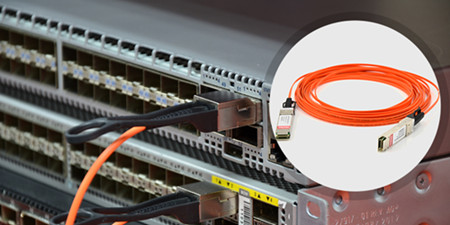As an indispensable component of network design, optical transceiver has been greatly improved in the past decades to cope with the increasing needs for speed and performance. From SFP, SFP+ to QSFP+, smart engineers will always promote a wise solution to realize higher-speed connectivity. For 40G network, 40GBASE-SR4 QSFP+ transceiver just like other modules can support conversion between optical signals and electrical signals of high data rate, making itself a commonly utilized interconnection solution in data center. And there is an alternative for 40G short-reach interconnection—AOC (active optical cable).
Usually, a 40G AOC cable contains a fiber optic cable terminated with QSFP+ connectors on both ends. Additionally, there is also other version of 40GBASE QSFP+ AOC with one end connected with a QSFP+ connector and the other end with several SFP+/XFP connectors., this is typically called fanout or breakout 40G AOC cable. 40GBASE QSFP+ to QSFP+ AOC has more advantages in transmission distance, bend radius, cable size, cable weight and cable management when compared with 40G copper DAC. Compared to 40GBASE-SR4 QSFP+ transceiver, 40G AOC avoids the need for fiber optic connectors and has a similar performance as the former, which seems to be a much more faster and easier methods for 40G interconnection. However, just like the coin has two sides, everything has its merits and demerits. To figure out which one is more suitable for your applications, a brief comparison between the two components will be offered in the following text. Figure 1 shows a 40GBASE AOC plugging into a switch.

Cost—Cost must be considered when choosing a solution for 40G interconnection. And the cost can be divided into two main aspects—material cost and the maintenance cost. The market price of 40G QSFP+ AOC is generally lower than 40G QSFP+ SR4 transceiver. To accomplish the connection, additional cost for patch cables should be considered for interconnection using 40G QSFP+ SR4 transceivers. For maintenance, as above mentioned, AOC is faster and easier which do not require much skills and saves labor. If the cost is limited, then AOC could be your choice.
Transmission Distance—Optical signals are weaken as the transmission distance increases. Thus, to ensure the transmission quality, the transmission distance should be the first aspects to determine which one is better for your applications. Generally, 40G QSFP+ SR4 can support longer transmission distance than that of 40G QSFP+ AOC. For 40G transmission, if the distance is less than 100 meters, 40G QSFP+ AOC and 40G SR4 QSFP+ transceiver could have nearly the same performances. However, when the transmission distance is longer than 100 meters, the performance of 40G AOC will be limited. In this case, 40GBASE-SR4 QSFP+ will have a better performance. For example, QSFP-40G-SR4 is Cisco 40GBASE-SR4 QSFP+ that can support a distance of 150m. Figure 2 shows a 40GBASE-SR4 QSFP+ and a OM3/OM4 MTP to LC break out cable, which provides a cost-effective solution for 40G interconnection for a distance of up to 150 m.

Reliability—Cables and connectors in data center inevitably need to be plugged out from devices like switches or servers for regular use and maintenance. With the actions of repeating plugging, the reliability and stability of a component became extremely important. The connectors of 40G AOC is factory pre-terminated, while QSFP+ SR4 transceivers is connected by additional MPO connectors and fiber optic cable. Thus, compared with QSFP+ SR4 transceiver, AOC is less affected by the repeating plug during daily use. In addition, there will be no insertion loss and return loss of 40G AOC, which can ensure its reliability furthermore. It has been proved that AOC has better reliability than that of transceivers.
Installation and Maintenance—Both 40G AOC and 40G QSFP+ SR4 transceiver are highly integrated components that provide increased port density and high data rate connection with great convenience during installation and maintenance. However, 40GBASE QSFP+ AOC is superior in this aspect. Take QSFP-H40G-ACU7M as an example, it is factory pre-terminated. Plug and play. It eliminates the process of linking two modules, which must be done for interconnection using 40G QSFP+ SR4 transceivers. Moreover, if there is a fault, you can just replace the AOC. However, the tests for the MPO connectors and cables are needed if 40G QSFP+ SR4 transceivers are used. Thus, AOC is easier and faster in installation and maintenance.
Conclusion
After going through the passage, we can draw a conclusion that for distances within 100 meters, 40GBASE QSFP+ AOC is more reliable and stable than 40GBASE SR4 QSFP+ transceiver and costs less. However, when the transmission distance is longer than 100 meters, 40GBASE QSFP+ AOC cannot perform as good as 40GBASE-SR4 QSFP+. Especially, with the function of DDM, this 40G transceiver can find its best working state, which is cannot be achieved by AOC. Fiberstore offers 40GBASE QSFP+ AOC and 40GBASE-SR4 QSFP+ transceivers with high quality and low price.
After going through the passage, we can draw a conclusion that for distances within 100 meters, 40GBASE QSFP+ AOC is more reliable and stable than 40GBASE SR4 QSFP+ transceiver and costs less. However, when the transmission distance is longer than 100 meters, 40GBASE QSFP+ AOC cannot perform as good as 40GBASE-SR4 QSFP+. Especially, with the function of DDM, this 40G transceiver can find its best working state, which is cannot be achieved by AOC. Fiberstore offers 40GBASE QSFP+ AOC and 40GBASE-SR4 QSFP+ transceivers with high quality and low price.
评论
发表评论